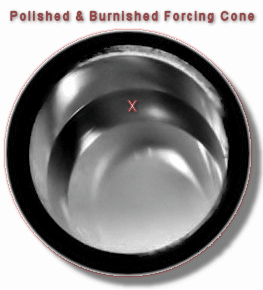The forcing cone in a shotgun barrel forces the shot charge or shot column down in diameter in transition from the shotgun chamber to enter the bore and then to enter the parallel section of the choke. The one we will concern ourselves with here is the chamber to bore forcing cone the other is contained within the choke or choke tube.
Short Factory Chamber To Bore Forcing Cone:

Lengthened Chamber To Bore Forcing Cone:

There has been a lot written on the subject of chamber to bore forcing cones, some good, some bad. The most experienced and authoritative goes to the late Ralph T. Walker. This appears to have been his life work. His book Gun Digest Book of Shotgun Gunsmithing is highly recommended to all who want the maximum from their shotguns. This is where I started my research as a gunsmith seeking out the ultimate in shot patterns, and it is here where the issue of forcing cones came into light for me.
Chamber forcing cones vary in length from 1/2″ to 2-1/2″ with many saying that this length or that length is perfect.
This is what I found after many hours at the lathe, chronograph, and patterning boards–1-1/2″ length will give you the best shot pattern performance, but, there is a catch to this and one that I did not see in any writings anywhere that really addressed this one issue: it is the amount of finish that you put on that 1-1/2″ forcing cone.
This is the one thing that makes or breaks successful shot pattern gains in lengthening a forcing cone, if the forcing cone is cut with a reamer of high quality the shot pattern may actually decrease if not honed some to remove the reamer ridges, if you proceed to hone the ridges then a pattern increase will start to come forward. The more you smooth out this area the more the pattern increases.

Most Important:
The end result to this is simple, cut with a reamer the forcing cone length to 1-1/2 inches, hone, polish the forcing cone, then when it is glass smooth, burnish it. This will seal the metal and a substantial gain in pattern density and evenness will be yours.
Can a longer forcing cone reduce recoil?
Simply put, the law of physics says for every action there is an opposite reaction. In a shotgun, you detonate powder which creates expanding gases that push to escape. In other words if you are pushing an object that weighs 1 ounce at a given velocity of say 1,200 feet per second in one direction the push factor in the opposite direction is exactly the same.
Felt recoil can be adjusted to give different effects by altering time frames to reach a given high point in recoil and by doing so you get more of a push effect than a punch effect at your shoulder.
Once a powder charge is ignited, it starts to push. In a barrel with a short forcing cone, the shot column that has to move is met with resistance from a steep, angled forcing cone trying to squeeze the shot column down to fit in the bore. Therefore, more pressure is needed to start moving it.
With a long forcing cone the shot column will instantly start moving freely into the bore requiring less force to move it because it is met with less resistance. As you can visualize here we just altered the time frame for the felt recoil from a punch to a push.
In both cases the shot column will accelerate until all powder is burned, giving us a desired amount of power from the expanding gases.
Can a longer forcing cone increase pattern density?
Simply put, yes. The reason that longer forcing cones give increased pattern density is that less pellets are being crushed at the back of the shot column. The reason for this is simple–the pellets in the back of the shot column have two forces working against them.
The expanding gases are trying to push them forward and the weight of all the pellets in the shot column are acting as a wall preventing them from moving forward.
In a short forcing cone the push to start moving all pellets forward is a sudden burst of pressure and the longer forcing cone allows the pellets to enter the bore in a slower push with less pressure thus not crushing the pellets and keeping more of the pellets in the pattern due to a lack of flier pellets with flat spots on them.

